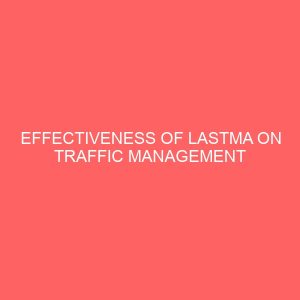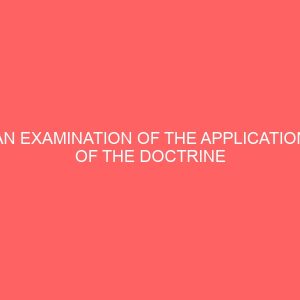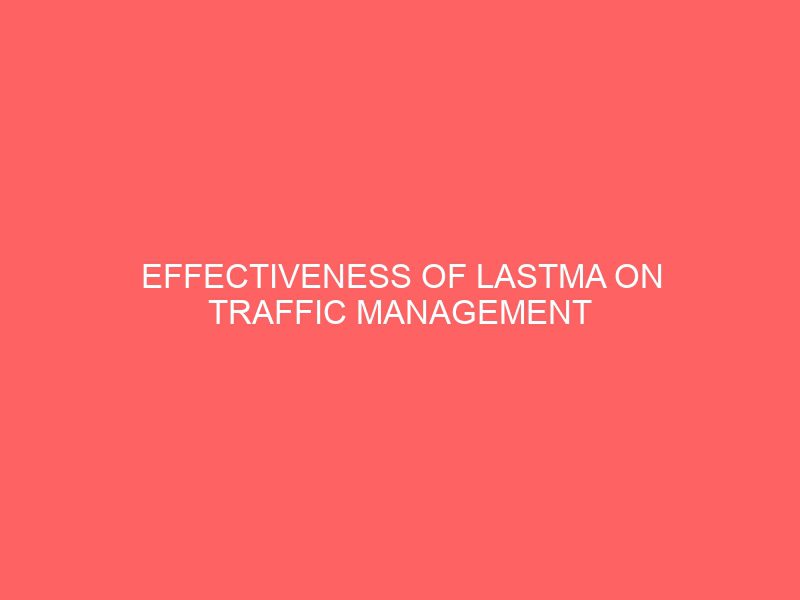Description
CHAPTER ONE
1.0 INTRODUCTION
1.1 Background to the Study
Traffic management is the practice of managing the existing traffic environment to create avenue for free flow of traffic, to control and manage traffic proceedings. Prior to 1999, the transport and vehicular traffic situation in Lagos State was in a state of neglect and confusion. There was terrible and high vehicle density in the state, studies carried out showed that that the vehicle density in the state is about “224 vehicles per km as against a national average of 15 vehicles per km of New York average of 24 vehicles per km with trams, trains, metro and waterways transportation” The resultant effect is the perennial road congestion with its attendant traffic logjam
According to LASTMA General Manager, Babatunde Edu, The situation of the Lagos roads before the establishment was frustrating, workers found it very difficult to get to their various working places at the normal time schedule, the situation even worsened when it rained because the traffic congestion would be doubled, compounded with the rough driving of the commuters; because of these problems, life was hectic and unbearable for most of workers in Lagos. Thus the condition many road users are faced with in Lagos was rather harrowing, begging for urgent government attention (Olasunkanmi, 2013).
Consequently, LASTMA was established and charged with the responsibility of ensuring the free flow of vehicular traffic in Lagos State in order to save journey time and improve the quality of life of Lagosians (Olasunkanmi, 2013).
Lagos State Traffic Management Authority (LASTMA) was established on the 15th of July, 2000 to control and manage traffic proceedings in Lagos state. According to an online source, the major purpose of creating LASTMA by the Lagos state government then under the authority of Governor Bola Hammed Tinubu was to develop a culture of orderly monitoring of road usage regulation and management of traffic operations state wide and to ensure free traffic flow on Lagos roads (Online/http:/www.wikil LASTMA/05/03/2013).
Additionally, LASTMA was established to make Lagos road safe and reduce to the barest minimum death, injuries and economic losses through road traffic accidents, congestion and delay by saving man hour wasted on public highway and ensure a sustainable economic growth in the state, also to ensure free flow of traffic for better social economic activities in the state. To reduce deaths, injuries and economic losses from road traffic accidents, conflicts, congestion and delays on the public highways in Lagos state by employing modern traffic management techniques and to inject order and control into the road traffic system (Atubi, 2006).
From the foregoing it is clear that the main duties or the main purpose for the establishment of LASTMA are; to develop a culture of orderly monitoring, road usage regulation and management of traffic operations state wide. To make Lagos roads are safe and reduce to the barest minimum death, injuries and economic losses through road traffic accidents, congestion and delay by saving man hour wasted on public highway and ensure a sustainable economic growth in the state; to ensure free flow of traffic, for better social economic activities in the state (Oni, 2004).
The task before this research work, therefore, is to make an evaluation or an appraisal of the activities of LASTMA so far for the past years; has LASTMA really been able to achieve the purpose which it was created for? What are the obstacles LASTMA has been facing in the past years and what are the successes they have been able to achieve? All these questions are what would constitute the appraisal or the evaluation of LASTMA achievements as traffic management body in Lagos state.
1.2 Statement of the Problem
Before LASTMA was established in Lagos the major problems on Lagos roads were; high traffic congestion, traffic log jam, high rate of road accidents, and poor driving culture of the motorist and the commuters or the road users in general. There was a poor observation of road rules and regulation, poor usage of the pedestrian bridge and so on. These problems resulted in several accidents and attendant loss of lives and limbs, loss of invaluable human hours in traffic and the attendant wear and tear in human and vehicular conditions. The problems also impacted negatively on business costs and efficiency and slowed down the socio-economic development of the state and country at large. These problems necessitated the establishment of LASTMA in 1999, so that heavy traffic jam in Lagos would be checked, to create avenue for free flow of vehicular traffic and to save time and improve the quality of life.
1.3 Aim and Objectives of the Study
The aim of this work is to look into the activities and achievements of LASTMA in Lagos since its creation and see whether it has been a success or a failure. Other specific objectives are:
1. To determine if traffic congestion as reduce in Yaba routes–Ojota routes
2. To determine if driving culture as be impacted on motorist..
3. To find out if LASTMA has had a positive effect on driving culture.
4. To find out public perception about LASTMA operatives.
1.4 Research Questions
The following research questions shall be answered in the course of the study.
1. Has the establishment of LASTMA had a positive effect on traffic congestions?
2. Has the establishment of LASTMA contributed to significant reduction of road accident?
3. Does LASTMA have any positive effect on the people’s driving culture?
4. What is the perception of members of the public about LASTMA operatives?
1.5 Research Hypotheses
Ho: The establishment of LASTMA in Lagos has no significant effect on traffic congestion.
Hi: The establishment of LASTMA in Lagos has significant effect on traffic congestion.
Ho: The establishment of LASTMA has no significant contribution to the reduction of road accident.
Hi: The establishment of LASTMA has significant contribution to the reduction of road accident
Ho: The establishment of LASTMA has no significant effect on driving culture.
Hi: The establishment of LASTMA has significant effect on driving culture.
1.6 Significance of the Study
This work is very significant because the research work will examine the effectiveness of LASTMA since its establishment and see if at all the organization has lived up to the expectation, if not the reason would also be discussed, thereby giving a detailed information about the performance, the prospect and the challenges of LASTMA in Lagos. With all these the research study will be useful for Lagos state government to evaluate the performance of LASTMA; it will also be useful for the public, LASTMA and for future researchers.
1.7 The Scope of the Study
The scope of this study will cover basically the public; which will include some selected motorists, commuters and other members of the public in Yaba area and Ojota road in Lagos metropolis.
The study area- Lagos Mega-city is located on the south-western coast of Nigeria along the bight of Benin between latitudes 60 and 70North of the equator and between longitudes 30 and 40 East of the Greenwich.
Population and Economic Activities
The Yoruba people constitute the city’s principal ethnic group, Lagos has a very diverse and fast growing population as a result of ongoing, migration from the rest of Nigeria and neighbouring countries, its population is about 15,000,000 (census, 2006)
Lagos receives most of Nigeria’s import trade, in particular consumer goods, foodstuffs, motor vehicles, machinery and industrial raw materials. Its exports trade, which includes timber and agricultural product such as cocoa, palm nut, and peanut, has declined. Since the 1970s more than half of Nigeria’s industrial capacity is located in Lagos mainland sub-urban, particularly in the Bceja Industrial Estate.
Lagos is the western terminus for the Nigerian railway system and is linked by rail and road also the Murtala Mohammed international airport is located in the sub-urban north-west of the city centre.
Lagos’s rapid unregulated growth coupled with the challenges of its fragmented eography has resulted in chronic traffic congestion on the city’s road. Despite this, there is relatively little in the way of boat transport between island and low land sections of Lagos.
1.8 Definition of Terms
Traffic: it is the movement of vehicles, ships, persons, etc. in an area, along a street, through an air plane, over a water route, etc.; it can also means the heavy traffic on the road or sea or the transportation of goods for the purpose of trade; by sea, land or air; ships of traffic.
Traffic management: Traffic management is the method of control for roadwork, that is, the measures that are generally intended to improve road safety for all its users and ease congestion or control the use of the cars. In other contexts, it could also refer to the process of determining timely and economic delivery methods, arranging both the internal and external transportation and ensuring that shipment status and logistics are efficiently tracked. Traffic management is a technique which specializes in providing customers, employees and the public a safe work zone while maintaining an efficient flow of traffic. This is done by combining many years of experience with new approaches and technologies to provide a fresh, progressive direction in the traffic control industry.
Traffic management initiatives help to keep our traffic moving at peak times and when over-dimension vehicles are using our roads or road works are being undertaken. It is the process or method of safely managing road users, including vehicles and pedestrians through, around or past an activity on a road reserve, with the minimum level of inconvenience.
Traffic control: Road traffic control involves directing vehicular and pedestrian traffic around a construction zone, accident or other road disruption, thus ensuring the safety of emergency response teams, construction workers and the general public. Traffic control also includes the use of CCTV and other means of monitoring traffic by local or State roadways authorities to manage traffic flows and providing advice concerning traffic congestion.
Traffic control is an outdoors occupation, night or day for long hours in all weathers, and is considered a dangerous occupation due to the high risk of being struck by passing vehicles. Safety equipment is vitally important.
Traffic congestion: Traffic congestion is a condition on road networks that occurs as use increases, and is characterized by slower speeds, longer trip times, and increased vehicular queuing. The most common example is the physical use of roads by vehicles. When traffic demand is great enough it leads to interaction between vehicles and slows the speed of the traffic stream, this results in some congestion. As demand approaches the capacity of a road (or of the intersections along the road), extreme traffic congestion sets in. When vehicles are fully stopped for periods of time, this is colloquially known as a traffic jam or traffic snarl-up. Traffic congestion can lead to drivers becoming frustrated and engaging in road rage.
Traffic flow: it is the total number of vehicles passing a given point in a given time, Traffic flow is expressed as vehicles per hour. In mathematics and civil engineering, traffic flow is the study of interactions between vehicles, drivers, and infrastructure (including highways, signage, and traffic control devices), with the aim of understanding and developing an optimal road network with efficient movement of traffic and minimal traffic congestion problems.
Road Development authority: The Road Development Authority (RDA) is the premier highway authority in the country and is responsible for the maintenance and development of the National Highway Network, comprising the Trunk (A Class) and Main (B Class) roads and the planning, design and construction of new highways, bridges and expressways to augment the existing network.







